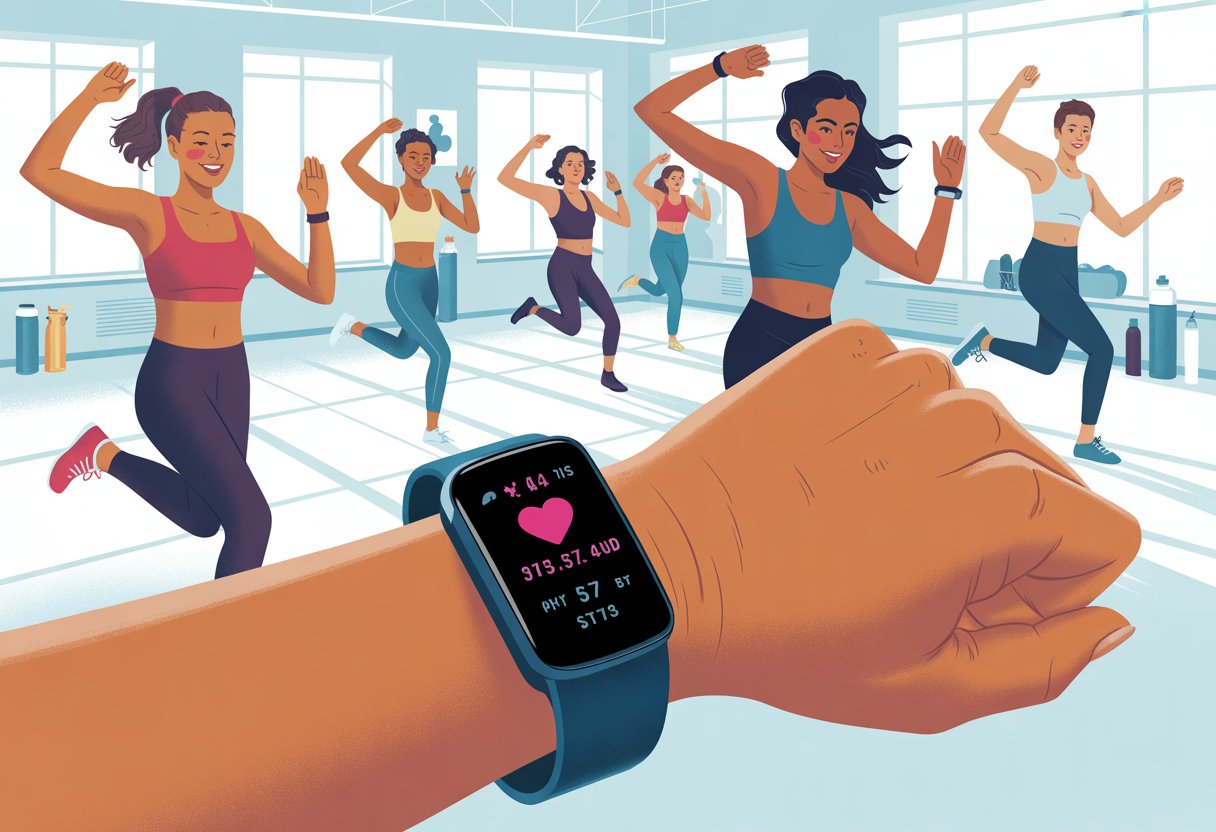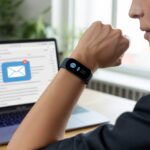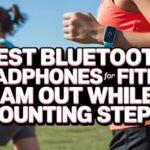We’ve all tried Zumba and wondered if those wild dance moves actually burn as many calories as we hope. By the end of class, our shirts are soaked, our hair’s a mess, and honestly, it has to count for something, right?
Using a fitness tracker during Zumba helps us track heart rate, calories, and workout length. We get real results—not just that “sweaty hair” badge of honor.

Most fitness trackers don’t list “Zumba” as a workout, but we can still track our salsa and shimmy with a few simple workarounds. Our trusty gadgets let us log sessions as “workout” or “aerobics,” and we can even rename them later for that extra bit of satisfaction (more info here).
Let’s grab our trackers, cue up our favorite playlist, and see if technology can keep up with our moves. Your Fitbit, Apple Watch, or Garmin might just become your new Zumba hype squad—minus the glittery costumes.
Choosing the Right Fitness Tracker for Zumba
Finding a good fitness tracker makes tracking our dance moves a lot easier—and honestly, a lot more fun. Picking the right one means we get the features we need without blowing our next grocery budget on something we’ll barely use.
Popular Wearable Devices for Dance Fitness
If you want a fitness tracker that can keep up with your Zumba routine (and not judge your questionable hips), you’ve got some solid options. The Fitbit Versa, Garmin Venu, and Apple Watch Series are all solid picks.
The Apple Watch brings dance tracking, heart rate monitoring, and even automatic workout detection. Fitbits are super popular because they’re easy to use and the battery just keeps going—almost as long as a Zumba playlist.
Garmin watches pack in strong health tracking and impressive battery life. Some folks use the Whoop Strap or Samsung Galaxy Watch for dance fitness too, but most people stick to the big three for accuracy, app support, and their ability to survive a serious sweat session.
Check out more about the best fitness trackers for all types of activities.
Features to Look for in Activity Trackers
We don’t want just any wrist candy—our tracker needs some brains too. Key features for Zumba include:
- Heart rate monitoring (because our pulse skyrockets with every shimmy)
- Step and movement tracking
- Calories burned
- Battery life (hopefully it lasts longer than one class)
- Water resistance (Zumba = sweat, always)
- Easy-to-read display for those quick mid-song glances
Some trackers let us control music or log different dance moves. If we can log workouts as “dance” or “workout,” it’s easier to keep records. According to Fitbit’s community, using the “Workout” mode covers most dance classes, Zumba included. We want an experience that’s smooth, not a tech struggle.
Comparing Brands: fitbit vs. garmin vs. apple watch
Fitbit stands out for being user-friendly, affordable, and having an app that’s actually pleasant to use. The battery lasts for days, which is great if you forget to charge it (guilty).
Garmin devices can be pricier, but they deliver deep health metrics and strong GPS. We probably won’t run a marathon during Zumba, but it’s handy if you cross-train.
Apple Watch looks great, tracks all sorts of activities (including dance), and syncs easily with iPhones. Downside? You’ll probably need to charge it more often, especially if you get a little too hyped.
Our choice depends on what matters: battery life, detailed stats, or just plain gadget envy. You can find more about tracking dance fitness and picking a good wearable.
Setting Up Your Fitness Tracker Before Your First Zumba Class
We want our fitness tracker to move with us at Zumba, not just sit there counting imaginary steps. Let’s get our devices ready so every sweaty move counts for something more than impressing the living room mirror.
Customizing Workout Profiles for Dance Fitness
Most trackers come loaded with basic workouts like running or cycling. But Zumba? That’s a different vibe.
We can edit workout shortcuts if our tracker allows it. Some devices don’t let us add “Zumba” by name, but we can pick “dance,” “aerobic,” or “other.” This tells the tracker we’re grooving, not jogging.
Automatic workout detection helps sometimes. Fitbit’s SmartTrack might lump Zumba under “aerobics” or “other.” Before class, check that your style is set for dance. If not, pick the closest thing and let those wrist flicks count.
Pairing Your Fitness Tracker with Wellness Platforms
Fitness trackers are good, but when we sync them to our favorite wellness platform, we get full credit for our salsa moves and questionable shimmies.
Download any required apps—yeah, another app, but it’s for your own good. Once installed, log in and connect your device. Most platforms will ask for permission to access workout and heart-rate data. Go ahead and agree, unless you’re hiding secret dance skills.
Some Zumba classes or online programs have their own apps too. These can sync with devices for a more complete view of your effort. Just make sure your platform supports your tracker and be ready to troubleshoot—fitness tech likes to be stubborn sometimes.
Ensuring Accurate Heart-Rate Monitor Settings
Our trackers can measure heart rate, but only if we wear them right. For best results, wear your device snug but not too tight—loose straps confuse the tracker.
Clean sensors work best. Wipe down the monitor before class, especially if you’ve been sweating at home. If your device has heart-rate tracking options, pick “on” or “continuous,” not “auto.” Less fiddling, more dancing.
Check your device settings to double-check tracking accuracy. Some trackers need calibration, so let your device know you’re not just sitting—you’re breaking a sweat at Zumba.
Tracking Your Zumba Sessions
Using a fitness tracker during Zumba helps us keep tabs on our heart rate, count calories burned, and remember if we actually worked out—or just forgot to turn the device on (again). Getting these basics right lets us brag with actual numbers, not just sweaty selfies.
Starting and Stopping Your Workout
First things first—actually press start on your tracker. Sounds obvious, but how many times have we realized it’s still “paused” from last week’s yoga? Set your mode to “Workout,” “Cardio,” or whatever’s closest to Zumba—most trackers don’t have a salsa icon yet. With the Fitbit Versa 3, for example, pick a generic workout and rename it to “Zumba” later. More details on the Fitbit forums.
When class (or your living room dance party) ends, hit stop. Some smartwatches auto-pause, but trusting tech with your calorie count? That’s like trusting a cat near an open tuna can. Always double-check.
Recording Continuous Heart Rate Metrics
Continuous heart rate tracking is where these gadgets shine. They monitor every beat, so later we can see how high our heart rate soared during those fast songs.
Tracking this helps us see if we’re getting a serious cardio workout or if we need to dance a bit harder. Many trackers show heart rate zones on a graph after the workout. This info helps us spot when we hit peak performance and when we might’ve just been “resting” (maybe gasping by the water fountain). The Apple Watch, for example, captures heart rate even if you pick a generic cardio workout—just choose the closest option and go, as explained in the Apple Community.
Log Calories Burned and Exercise Intensity
Most fitness trackers use heart rate, motion sensors, and our profile (age, weight, height) to estimate calories burned during Zumba. We need to start the tracker at the right time and pick the right activity for the best reading. Some devices, like Fitbit, let us edit the workout after to label it “Zumba,” making stats more specific—including graphs of calories and intensity.
Trackers usually display calories burned at the end, often with exercise intensity or “active minutes.” These numbers help when we’re chasing daily goals or justifying an extra snack. For more on getting credit for every shimmy, visit the Zumba app FAQ.
Analyzing Your Zumba Performance
We all know Zumba leaves us sweating and wondering if we’ve actually improved or just managed not to trip over our own feet. Using a fitness tracker helps us spot what’s working, what’s not, and how close we are to our next dance triumph.
Interpreting Workout Data
Our trackers throw a ton of numbers at us: calories, heart rate, steps, and workout length. The real trick is figuring out what these stats mean for our Zumba sessions.
For Zumba, calories burned give us a clue about how intense our dancing was. A high heart rate? That means we’re going all in—and probably gasping for air. If our watch doesn’t offer a Zumba mode, using the “Other Workout” or “Workout” option still lets us log the essentials and even rename the activity later, just like people do with Fitbit Versa.
Sometimes, the step count is hilariously optimistic—apparently, every sassy hip shake counts. But tracking consistency across our Zumba routines helps us challenge ourselves and keep those fitness goals in sight. If our progress stalls, maybe it’s time to dance a little wilder or add another song to the playlist.
Identifying Trends in Your Fitness Goals
Let’s play detective and dig through our tracker’s data. Are we burning more calories with each class lately? Has our average heart rate during Zumba dropped, maybe showing off a bit more stamina?
When we spot these patterns, the whole fitness thing feels less random—like, not just us tripping over our own feet during a salsa spin.
We can check progress with weekly or monthly summaries. If charts and graphs make your head spin, just look for simple stuff: longer activity streaks, more minutes, or maybe a new calorie record.
These little trends show if we’re moving toward our goals or just spinning in circles.
Let’s not skip celebrating small wins. Noticing these changes keeps us motivated and helps us tweak our routines.
We’ll know when it’s time to punch up our dance moves, try a tougher class, or just treat ourselves for surviving another wild Zumba session.
Extending Battery Life During Dance Workouts
Nobody wants their fitness tracker to quit before we finish our last Zumba shuffle. If we manage battery life well, we’ll spend less time charging and more time dancing.
Staying powered up means our stats stay accurate. Plus, we can avoid that awkward moment when the screen goes dark mid-song.
Battery Saving Tips for Long Zumba Sessions
Let’s be real—our trackers are cool, but their batteries sometimes just can’t keep up. With a Fitbit Charge or Jawbone, lowering the screen brightness and switching off notifications can really help.
If we’re in it for the long haul, using battery saver or power-saving modes turns off extras like heart rate tracking when we don’t need them.
It’s a good idea to sync our data before class starts. That way, our device won’t waste energy trying to connect while we’re busy busting a move.
Keeping the software up to date helps too, since updates usually improve battery life.
When nothing else works, flipping our tracker into airplane mode during class keeps it focused on our steps and not buzzing every time someone texts about pizza.
Getting More from Your Fitness Tracker for Zumba
We want more than step counts and “why are you so sweaty?” looks from our trackers. With a little know-how, we can track our dance moves, show off our progress, and even team up with a fitness pro for better results.
Syncing and Sharing Progress with Friends
Let’s be honest—competing with friends makes working out way more fun. Most fitness trackers let us sync our workout data to apps or social networks.
We can see who logged the most Zumba minutes or burned the most calories, then toss some digital confetti and brag a little.
Many fitness apps and trackers let us join group challenges or share stats automatically.
Dancing for fun is great, but dancing because Karen is ahead of us? That’s real motivation.
Sharing progress keeps us accountable, helps us celebrate, and might even nudge our friends to stick with their goals. It’s the best kind of peer pressure—powered by Zumba.
Using Your Fitness Tracker with a Fitness Professional
Working with a fitness professional really changes how you use your tracker. If you show up to an in-person Zumba class, you can just pull up your stats from last week and share them with your instructor.
They might glance at your heart rate, calories burned, or even how many times your left shoe nearly went flying. Then, they’ll toss out some advice or maybe switch up your routine on the spot.
Trainers actually use your tracker data to build new routines and suggest tweaks for better results. Sometimes, they’ll help you steer clear of injuries, which honestly, we could all use.
Some trackers even link up with apps used by pros. It kind of makes you feel like an Olympic athlete—even if you’re just dancing around your living room.
Bragging rights plus a bit of expert guidance? That’s a combo totally worth showing up for.
- Best Bluetooth Headphones for Airplane Travel: Drown Out Crying Babies in Style - December 8, 2025
- How to use Bluetooth headphones with an intercom system and Finally Escape Tangled Wires - December 7, 2025
- Best Fitness Trackers for Silent Alarms: Wake Up Without the Drama - December 7, 2025






